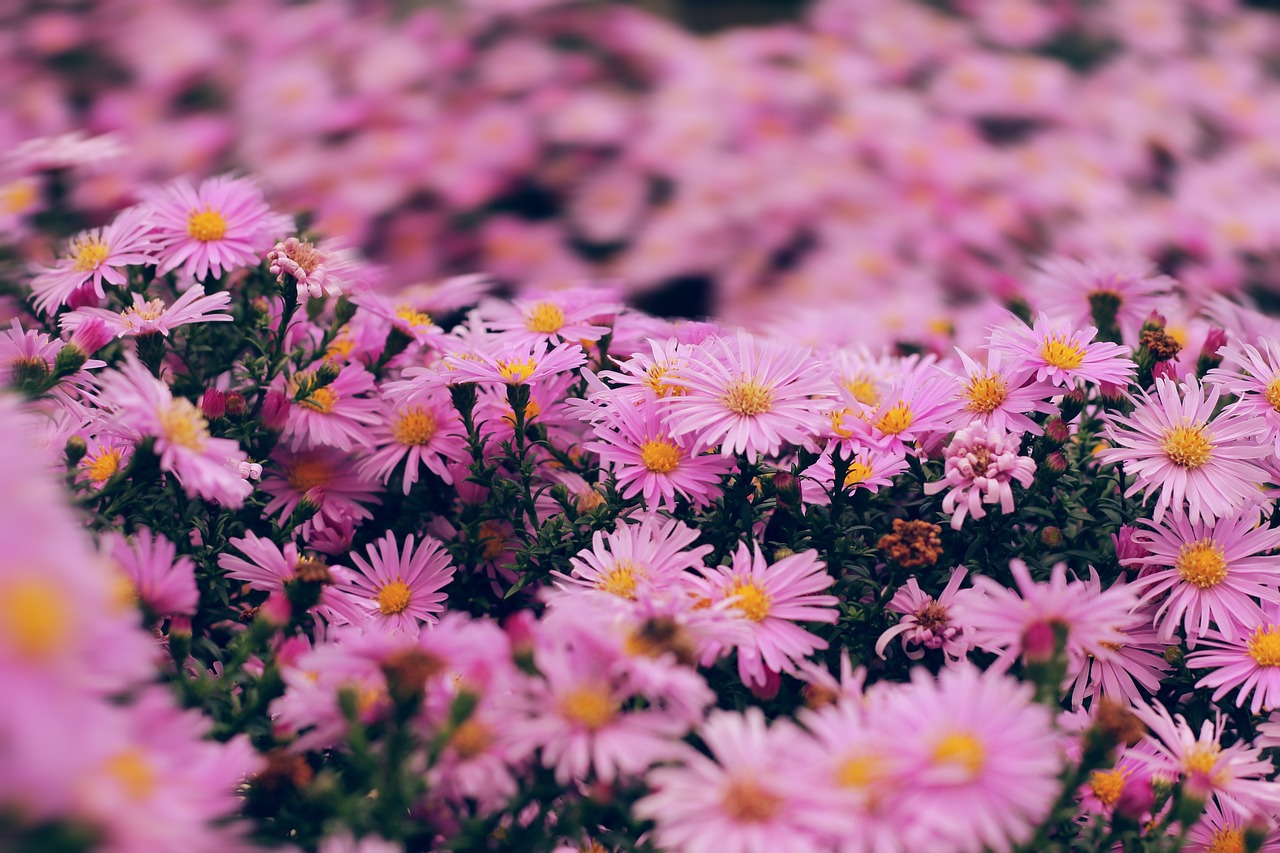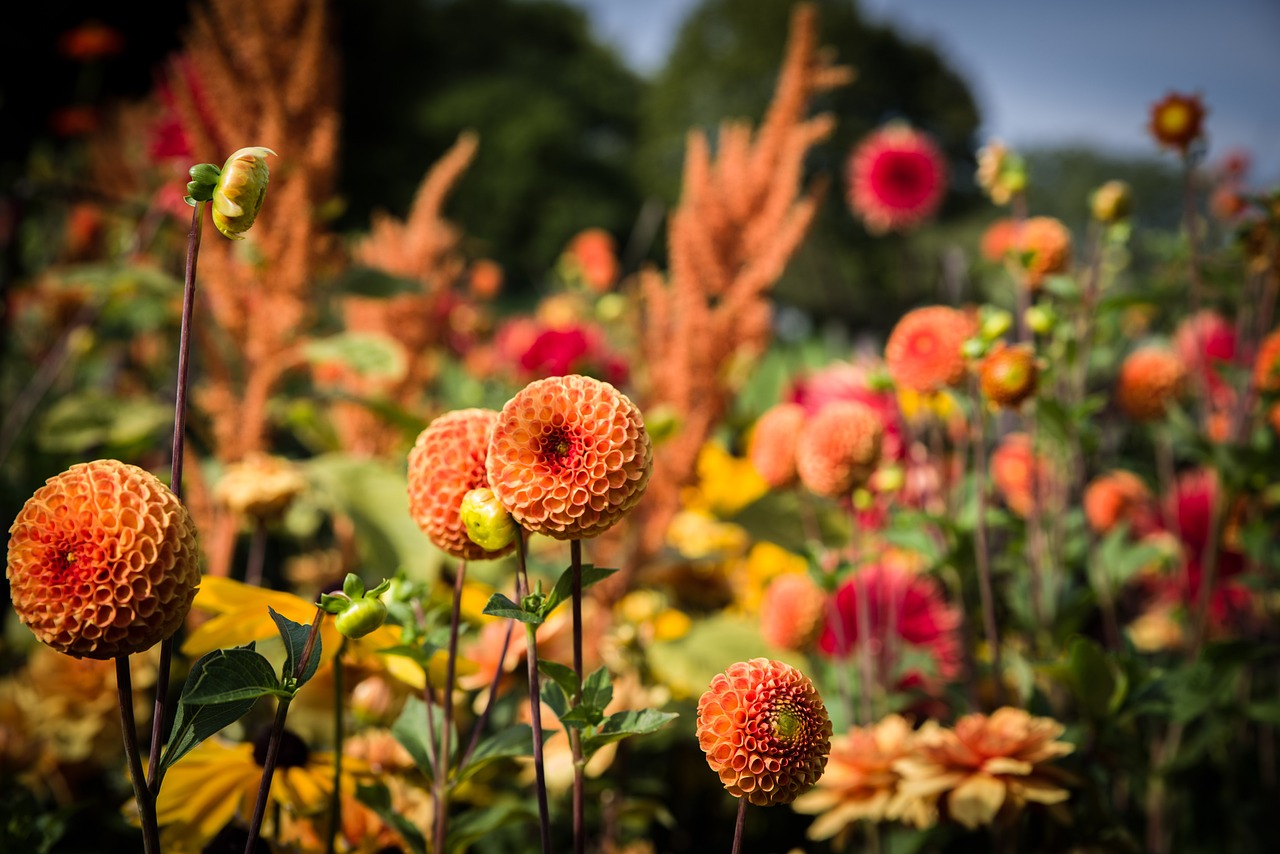How to Create a Vegetable Vertical Garden
Creating a vegetable vertical garden is an exciting and innovative way to transform your gardening experience. Imagine being able to grow fresh vegetables in a limited space, perhaps on a balcony, patio, or even a small backyard. Vertical gardening not only maximizes your available area but also adds a stunning visual element to your surroundings. It's like turning your ordinary wall into a lush, green masterpiece! In this article, we'll explore the benefits of vertical gardening, how to choose the right location, the materials you'll need, and much more. By the end, you'll be equipped with all the knowledge necessary to embark on your own vertical gardening adventure.
Vertical gardening offers numerous advantages that can enhance both productivity and aesthetics in your garden. First and foremost, it is a space-saving solution. If you live in an urban area where ground space is limited, vertical gardens allow you to utilize vertical space effectively. This means you can grow more plants without needing a larger footprint.
Additionally, vertical gardens improve air circulation around your plants. When plants are spaced apart and elevated, they receive better airflow, which can reduce the risk of diseases such as mold and mildew. This is especially important for leafy greens and other vegetables that thrive in well-ventilated environments.
Another significant benefit is the easier access to your plants. When you have a vertical garden, you can tend to your plants without bending down or kneeling, making gardening a more enjoyable and less strenuous activity. Plus, it can be easier to spot pests or diseases when your plants are at eye level!
Selecting an optimal location is crucial for a successful vertical garden. Consider factors like sunlight, as most vegetables require at least 6-8 hours of direct sunlight each day. If your chosen spot is shaded by trees or buildings, you may need to reconsider. Wind exposure is another important factor; strong winds can damage delicate plants, so look for a location that offers some protection.
Accessibility is also key. You want to ensure that you can easily reach your plants for watering, harvesting, and maintenance. Think of it as setting up your gardening workstation—convenience is everything!
Understanding the materials required for constructing your vertical garden is essential. Here are some options you might consider:
- Trellises: These structures provide support for climbing plants.
- Containers: Use pots or planters to hold soil and plants.
- Soil: Choose a high-quality potting mix to ensure proper drainage and nutrients.
Gathering the right materials beforehand will help streamline the process and make your gardening experience smoother.
There are countless creative designs for vertical gardens. From wall-mounted planters to freestanding structures, the possibilities are endless. You might want to consider a modular system that allows you to expand your garden over time, or perhaps a pallet garden that gives a rustic charm. Think about using recycled materials, such as old wooden crates or plastic bottles, to create a unique and eco-friendly garden.
Not all vegetables are suited for vertical gardening, but many climbing varieties thrive in this setup. Some of the best crops to grow vertically include:
- Cucumbers: These plants love to climb and produce abundant fruit.
- Tomatoes: Indeterminate varieties can be trained up trellises.
- Beans: They naturally climb and are perfect for vertical gardens.
Choosing the right vegetables will not only maximize your space but also enhance your overall yield.
Proper planting techniques are key to a successful vertical garden. Pay attention to spacing, as overcrowding can lead to poor air circulation and competition for nutrients. Generally, plants should be spaced according to their mature size. Additionally, consider the depth of the containers you use; some plants require deeper soil to establish robust root systems.
Support systems are also essential. Use stakes, netting, or trellises to guide your plants as they grow upwards. Think of this as giving your plants a helping hand to reach for the sky!
Maintaining a vertical garden requires specific care. Regular watering is crucial, especially for container gardens, as they can dry out more quickly. Consider using a drip irrigation system to make this task easier. Additionally, fertilizing your plants with a balanced organic fertilizer will promote healthy growth. Keep an eye out for pests and diseases; early detection is key to preventing larger issues down the road.
Harvesting from a vertical garden can be incredibly rewarding. When the time comes, be sure to pick your vegetables at their peak ripeness for the best flavor. This is where all your hard work pays off! Incorporate your fresh produce into delicious meals, and share your bounty with friends and family. After all, nothing beats the taste of homegrown vegetables!
Q: Can I grow flowers in a vertical garden?
A: Absolutely! Many flowers can thrive in vertical gardens, adding beauty and attracting pollinators.
Q: How do I prevent pests in my vertical garden?
A: Regularly inspect your plants, use organic pest control methods, and ensure good airflow to minimize pest problems.
Q: Is vertical gardening suitable for beginners?
A: Yes! Vertical gardening can be a great starting point for new gardeners, as it simplifies many aspects of plant care.

Benefits of Vertical Gardening
Vertical gardening is not just a trendy way to display plants; it’s a revolutionary approach to maximizing your gardening potential. Imagine transforming a small balcony or a limited backyard space into a lush, green oasis that not only looks stunning but also provides fresh produce right at your fingertips. One of the most significant benefits of vertical gardening is its ability to save space. By growing plants upwards instead of outwards, you can cultivate a larger variety of vegetables in a compact area. This is particularly beneficial for urban dwellers who may not have access to large plots of land.
Moreover, vertical gardens enhance air circulation, which is crucial for plant health. When plants are spaced too closely together on the ground, they can become overcrowded, leading to poor airflow and increased susceptibility to diseases. By elevating your plants, you allow for better ventilation, reducing the risk of mold and mildew. This is especially important in humid climates where moisture can linger around plants.
Another advantage is the ease of access to your plants. No more bending down or kneeling in the dirt to reach your vegetables! Vertical gardens can be designed at a height that is comfortable for you, making it easier to tend to your plants, harvest them, and even perform routine maintenance. This accessibility is particularly beneficial for those with mobility issues or anyone who simply wants to make gardening a less strenuous activity.
Additionally, vertical gardening can significantly enhance the aesthetic appeal of your space. A wall of green can serve as a beautiful backdrop, transforming a dull area into a vibrant sanctuary. You can incorporate various colors and textures by using different plants, creating a living piece of art. This not only improves your mood but can also increase the value of your property. According to studies, homes with well-maintained gardens can see an increase in value by as much as 20%!
Lastly, vertical gardens can contribute to better environmental health. Plants naturally purify the air by absorbing carbon dioxide and releasing oxygen. By increasing the number of plants in your living space, you’re actively participating in reducing your carbon footprint. Furthermore, vertical gardens can help with urban heat reduction, acting as natural insulators and cooling down the surrounding areas.
In conclusion, the benefits of vertical gardening extend beyond just saving space. From improving air circulation and accessibility to enhancing aesthetics and contributing to environmental health, vertical gardens are a fantastic solution for anyone looking to maximize their gardening experience. So, why not consider starting your very own vertical garden and enjoy the myriad of advantages it brings?

Choosing the Right Location
When it comes to creating a thriving vegetable vertical garden, choosing the right location is absolutely crucial. Think of your plants as little sunbathers—just like us, they need the right conditions to flourish! An ideal spot will not only provide adequate sunlight but also shield your plants from harsh winds and give you easy access for maintenance. So, where do you start?
First and foremost, consider sunlight. Most vegetables require at least 6 to 8 hours of direct sunlight each day. Observe your garden space throughout the day to identify which areas receive the most sun. If you notice that certain spots are shaded by trees or buildings, it might be wise to avoid those areas. Imagine your plants stretching their leaves towards the sun—it's a beautiful sight!
Next, examine the wind exposure. Wind can be a double-edged sword; while it can help with air circulation, strong gusts can damage delicate plants. If your garden is exposed to high winds, consider positioning your vertical garden against a wall or fence to provide a buffer. Alternatively, you could use windbreaks like tall plants or trellises to protect your veggies. Think of it as giving your plants a cozy blanket on a chilly day!
Accessibility is another vital factor. You want to ensure that your vertical garden is easy to reach for watering, harvesting, and general maintenance. If your garden is tucked away in a corner, you might find yourself skipping those essential tasks. Try to position your vertical garden in a spot that invites you to interact with it daily. After all, gardening is not just a chore; it's a rewarding hobby that brings joy and relaxation!
Lastly, consider the soil quality in your chosen location. Even if you have the best sunlight and wind protection, poor soil can hinder your plants' growth. Test the soil to ensure it drains well and has the right pH levels for the vegetables you plan to grow. If your soil is lacking, you can always amend it with organic matter or create raised beds to provide a nutrient-rich environment. Think of your soil as the foundation of a house; without a solid base, everything else crumbles!
In summary, choosing the right location for your vertical garden involves a careful balance of sunlight, wind protection, accessibility, and soil quality. By taking the time to evaluate these factors, you’ll set the stage for a flourishing garden that not only looks stunning but also yields delicious produce. So, grab your gardening gloves and get ready to create a vertical paradise!

Materials Needed
Creating a vegetable vertical garden is an exciting journey, but before you dive in, it's crucial to gather the right materials. Think of it as assembling your toolkit for a DIY project; you wouldn’t want to start without all the essentials, would you? The materials you choose will not only affect the ease of building your garden but also the health and growth of your plants. So, let’s explore what you’ll need to make your vertical garden flourish!
First up, you’ll need a sturdy frame or support system. This could be a trellis, a wall-mounted planter, or even a repurposed wooden pallet. The frame acts like the backbone of your garden, providing the necessary support for your climbing vegetables. When selecting your frame, consider materials that can withstand the elements if your garden is outdoors. Options include:
- Wood: Natural and aesthetically pleasing, but ensure it's treated for outdoor use.
- Metal: Durable and long-lasting, perfect for a modern look.
- Plastic: Lightweight and resistant to rot, but may not be as sturdy.
Next, you’ll need containers. These can range from hanging pots to vertical planters. The beauty of vertical gardening is that you can use a variety of containers to create visual interest. Make sure your containers have proper drainage holes to prevent waterlogging, which can lead to root rot. Here’s a quick table summarizing some container options:
| Container Type | Best For | Pros | Cons |
|---|---|---|---|
| Hanging Baskets | Herbs, strawberries | Space-saving, decorative | May require more frequent watering |
| Wall Planters | Leafy greens, flowers | Maximizes vertical space | Can be heavy when filled |
| Pallet Planters | Root vegetables, flowers | Recycled material, unique design | May need reinforcement |
Soil is another vital component. You’ll want a high-quality potting mix that provides good drainage and retains moisture. Consider blending in some compost to enrich the soil with nutrients, giving your plants a healthy start. Remember, the soil is like the foundation of a house—if it’s not solid, everything else will crumble!
Finally, don’t forget about watering and fertilizing tools. A drip irrigation system can be a game-changer, allowing you to efficiently water your vertical garden without the hassle of manual watering. Additionally, having a good fertilizer on hand will help your plants thrive, especially during the peak growing season.
In summary, the materials needed for a successful vertical garden include:
- Support structure: Trellises, wall planters, pallets.
- Containers: Hanging baskets, pots, vertical planters.
- Soil: Quality potting mix with compost.
- Watering and fertilizing tools: Drip irrigation, fertilizers.
With these materials in hand, you’re well on your way to creating a stunning vertical garden that not only saves space but also adds charm to your outdoor or indoor space. So, roll up your sleeves, gather your supplies, and get ready to dig into this rewarding gardening adventure!
Q: Can I use any type of soil for my vertical garden?
A: It's best to use a high-quality potting mix designed for container gardening. This ensures good drainage and adequate nutrients for your plants.
Q: How often should I water my vertical garden?
A: The frequency of watering depends on the type of plants and the weather conditions. Generally, check the soil moisture regularly and water when the top inch feels dry.
Q: What vegetables grow best in vertical gardens?
A: Climbing vegetables such as tomatoes, cucumbers, and pole beans are excellent choices for vertical gardening as they naturally grow upwards.
Q: How can I prevent pests in my vertical garden?
A: Regularly inspect your plants and use organic pest control methods like neem oil or insecticidal soap to keep pests at bay.
With this knowledge, you’re ready to tackle your vertical gardening project with confidence!

Design Ideas for Vertical Gardens
When it comes to vertical gardening, the design possibilities are as endless as your imagination! Think of your vertical garden as a canvas waiting for your creative touch. Whether you have a small balcony or a spacious backyard, there are countless ways to transform your space into a lush, green paradise. One popular idea is to use wall-mounted planters. These are not only functional but also serve as stunning wall art. Imagine stepping out onto your patio and being greeted by a vibrant tapestry of greens and colors, all thanks to your vertical garden. You can use a variety of containers, from repurposed wooden crates to sleek metal pots, to create an eye-catching display.
Another fantastic option is to incorporate trellises or grids into your design. These structures provide support for climbing plants, allowing them to reach new heights—literally! You can create a stunning focal point by placing a trellis against a blank wall or even in the center of your garden. As the plants grow and intertwine, they’ll create a beautiful, living sculpture that changes with the seasons.
If you’re looking for something a bit more unconventional, consider using a vertical pallet garden. Old wooden pallets can be easily transformed into vertical planters with a little creativity. Simply lean the pallet against a wall, fill the slats with soil, and plant your favorite herbs or flowers. This not only recycles materials but also adds a rustic charm to your garden.
For those with a flair for the modern aesthetic, vertical garden kits are available that come with sleek, modular designs. These kits often include built-in irrigation systems and are made from durable materials, making them a great choice for the busy gardener. You can stack them, arrange them in different configurations, or even create a living wall that acts as a natural air filter.
Here are a few more design ideas to consider:
- Hanging Gardens: Use macramé hangers to suspend pots from the ceiling or a sturdy beam. This not only saves space but also adds a whimsical touch to your vertical garden.
- Vertical Hydroponics: If you’re feeling adventurous, why not try a hydroponic setup? These systems allow you to grow plants without soil, using nutrient-rich water instead, and can be arranged vertically for a stunning effect.
- Faux Green Walls: If you’re short on time or gardening experience, consider installing faux green walls. These require no maintenance and can instantly transform your space with a lush appearance.
Remember, the key to a successful vertical garden is not just in the plants you choose but also in how you arrange them. Layering plants with varying heights and textures will create depth and interest. Think of it as composing a symphony, where each plant plays its part in creating a harmonious blend of colors and forms.
In conclusion, designing your vertical garden should be a fun and fulfilling experience. Whether you opt for a simple wall-mounted planter or a complex trellis system, the goal is to create a space that reflects your personality and gardening style. So roll up your sleeves, get creative, and watch your vertical garden flourish!
Q: What types of plants are best for vertical gardening?
A: Climbing plants like beans, peas, and cucumbers are excellent choices. Herbs like basil and mint also thrive in vertical gardens.
Q: How much sunlight do vertical gardens need?
A: Most vegetables require at least 6-8 hours of sunlight daily. Ensure your vertical garden is placed in a location that receives adequate light.
Q: Can I use any container for my vertical garden?
A: It’s best to use containers that provide good drainage. Ensure that the materials are suitable for outdoor use to withstand the elements.

Best Vegetables for Vertical Gardening
When it comes to vertical gardening, not all vegetables are created equal. Some plants are naturally inclined to climb and thrive when given the right support, while others may struggle in a vertical setup. Choosing the right vegetables can make a significant difference in both the aesthetics and productivity of your garden. So, what are the best options for your vertical garden? Let’s dive into the world of climbing vegetables!
First up, we have tomatoes. These juicy delights are a favorite among gardeners and for good reason. With their vining nature, tomatoes can easily be trained to grow upward using trellises or cages. Not only do they save space, but they also enjoy better air circulation, reducing the risk of diseases. Just imagine plucking fresh, sun-ripened tomatoes right from your vertical garden!
Next on the list are cucumbers. These crunchy veggies love to climb and can be incredibly productive when grown vertically. By using a simple trellis, you can keep cucumbers off the ground, which helps prevent rot and makes harvesting a breeze. Plus, the sight of lush green cucumber vines climbing skyward is a beautiful addition to any garden.
Another fantastic option is pole beans. These legumes are not only delicious but also incredibly easy to grow vertically. By planting them at the base of a trellis, you’ll be rewarded with a bountiful harvest that can reach great heights. Beans are also great for your soil, as they fix nitrogen, enriching the earth for future plants.
Don’t forget about peas! These sweet little gems thrive when given vertical support. They can be planted early in the season and will climb happily up a trellis, providing you with a delightful harvest of fresh peas. The best part? They’re perfect for snacking straight from the vine!
Let’s not overlook zucchini. While typically a bush vegetable, certain varieties can be trained to grow vertically. By providing a sturdy support system, you can enjoy the benefits of growing zucchini without taking up too much ground space.
In summary, here’s a quick look at some of the best vegetables for vertical gardening:
- Tomatoes
- Cucumbers
- Pole Beans
- Peas
- Zucchini
By selecting these climbing vegetables, you’ll not only maximize your space but also create a stunning visual display. Remember, the key to a successful vertical garden is to choose plants that are naturally inclined to climb and that will thrive in your specific growing conditions. Happy gardening!
Q: Can I grow any vegetable vertically?
A: Not all vegetables are suited for vertical gardening. Look for climbing or vining varieties, such as tomatoes, cucumbers, and beans, for the best results.
Q: How much sunlight do vertical gardens need?
A: Most vegetables require at least 6-8 hours of direct sunlight daily. Ensure your vertical garden is placed in a location that receives adequate sunlight.
Q: How do I support my vertical vegetables?
A: Use trellises, cages, or other support systems to help your plants climb. Make sure the support is sturdy enough to handle the weight of the mature plants.
Q: Can I grow herbs in a vertical garden?
A: Absolutely! Many herbs, such as basil, parsley, and mint, can thrive in a vertical garden setup. They can be grown in containers or wall-mounted planters.
Q: How often should I water my vertical garden?
A: Vertical gardens may need more frequent watering due to increased exposure to sunlight and wind. Check the moisture level regularly and water as needed.

Planting Techniques
When it comes to planting in your vertical garden, the techniques you use can make all the difference between a thriving oasis and a struggling patch. First off, spacing is crucial. You don’t want your plants to feel cramped, as this can lead to competition for nutrients and sunlight. Generally, you should aim for about 12 to 18 inches between larger plants, while smaller varieties can be spaced closer together. Think of it like a dance floor; everyone needs enough room to show off their moves without stepping on each other’s toes!
Next, consider the depth of your planting containers. A good rule of thumb is to ensure that the containers are at least 12 inches deep for most vegetables. This depth allows for adequate root growth, which is essential for healthy plants. If you’re using wall-mounted planters, make sure they have enough soil to support the roots without drying out too quickly. Remember, just like a well-cooked meal, the right ingredients and proportions are key!
Support systems are another vital aspect of planting techniques in a vertical garden. Many climbing plants, such as tomatoes and cucumbers, will need some assistance to grow upwards. This is where trellises, netting, or even simple bamboo stakes come into play. When installing these supports, ensure they are sturdy enough to hold the weight of your plants as they grow. It’s like giving your plants a reliable partner to lean on as they reach for the sky!
Watering techniques also differ in a vertical garden. Because the plants are elevated, they may dry out faster than those in traditional gardens. Consider using a drip irrigation system or self-watering containers to keep moisture levels consistent. This approach not only saves time but also ensures that your plants receive the right amount of water without the risk of overwatering. Think of it as setting up a hydration station for your green friends!
Lastly, let’s talk about companion planting. This technique involves planting compatible vegetables close to each other to maximize growth and minimize pests. For example, basil and tomatoes are a classic duo that not only thrive together but also enhance each other’s flavors. When planning your vertical garden, think about which plants can benefit from being neighbors. It’s like creating a community where everyone supports one another!
In summary, mastering the planting techniques for your vertical garden involves careful consideration of spacing, depth, support systems, watering methods, and companion planting. By paying attention to these details, you’ll set the stage for a flourishing garden that not only looks great but also yields delicious vegetables. So roll up your sleeves, grab your tools, and get ready to plant your way to vertical gardening success!
1. What vegetables are best for vertical gardening?
Many climbing vegetables like tomatoes, beans, cucumbers, and peas thrive in vertical gardens. Choose varieties that naturally grow upwards.
2. How often should I water my vertical garden?
Watering frequency depends on the climate and the type of plants you are growing. Generally, check the soil moisture regularly and water when the top inch feels dry.
3. Can I use regular soil for my vertical garden?
It’s best to use a high-quality potting mix that provides good drainage and aeration. Regular garden soil may compact too much in containers, hindering root growth.
4. How do I prevent pests in my vertical garden?
Regularly inspect your plants, use organic pest control methods, and consider companion planting to naturally deter pests.
5. Is vertical gardening suitable for small spaces?
Absolutely! Vertical gardening is perfect for small spaces as it maximizes your growing area without requiring a large footprint.

Maintenance Tips
Maintaining a vertical garden is like nurturing a living piece of art; it requires attention, love, and the right techniques to flourish. Just as we wouldn’t neglect a canvas, your plants deserve the same dedication. One of the first things to consider is watering. Vertical gardens can dry out faster than traditional gardens due to their exposure to air and sunlight. Aim to check the moisture level in your soil regularly. A good rule of thumb is to stick your finger about an inch deep into the soil. If it feels dry, it’s time to water. Remember, consistency is key; you don’t want your plants to experience drought stress or soggy roots!
Next up is fertilizing. Vertical gardens often have limited soil volume, which means nutrients can be depleted more quickly than in ground gardens. Use a balanced, slow-release fertilizer to provide your plants with the nutrients they need. Additionally, consider supplementing with organic compost every few weeks. This not only enriches the soil but also enhances its structure, allowing for better moisture retention and root development.
Now, let’s talk about pest control. Just like any garden, a vertical garden can attract pests. Regularly inspect your plants for signs of infestation, such as discolored leaves or visible bugs. If you spot any unwelcome guests, don’t panic! You can use a mixture of water and mild soap as a natural pesticide. Just spray it on the affected areas, and it’ll help to keep those pesky critters at bay. Additionally, introducing beneficial insects like ladybugs can provide a natural form of pest control.
Another crucial aspect of maintenance is pruning. As your plants grow, they may become overgrown or tangled. Regularly trimming back foliage not only keeps your garden looking neat but also encourages new growth and improves air circulation. This is particularly important in vertical gardens, where good airflow can prevent mold and mildew.
Finally, don’t forget about support systems. As your plants grow taller, they may need additional support to stay upright. Regularly check your trellises or supports to ensure they’re sturdy enough to hold your plants. You might need to adjust or reinforce them as your plants grow. Think of it like giving your plants a sturdy backbone!
In summary, maintaining a vertical garden is an ongoing process that involves consistent watering, fertilizing, pest control, pruning, and ensuring adequate support. By paying attention to these aspects, you can create a thriving vertical oasis that not only looks beautiful but also produces an abundance of fresh vegetables.
To wrap things up, let's tackle some common questions about maintaining a vertical garden:
- How often should I water my vertical garden? It depends on the plant types and weather conditions, but generally, check the soil moisture every few days.
- Can I use regular garden soil in my vertical garden? While you can, it's often better to use a lightweight potting mix designed for container gardening.
- What should I do if my plants are wilting? Check for water, sunlight, and pests. A combination of these factors could be causing stress.
- Is it necessary to use fertilizers? Yes, especially in limited soil environments, as nutrients can be quickly depleted.

Harvesting and Enjoying Your Garden
Harvesting from your vertical garden is not just about gathering vegetables; it's an experience that connects you with the fruits of your labor. Imagine the thrill of plucking a ripe tomato or crisp cucumber, knowing that you nurtured it from a tiny seed to a thriving plant. The moment you bite into a freshly picked vegetable, the burst of flavor is like nothing you can find in a store. But how do you ensure you harvest at the right time for maximum taste and nutrition?
Firstly, timing is everything. Each vegetable has its own ideal harvest window. For instance, tomatoes should be picked when they are fully colored and slightly soft to the touch, while cucumbers are best when they are firm and still small. To help you keep track, here’s a quick table of some popular vertical garden vegetables and their ideal harvesting times:
| Vegetable | Harvest Time | Signs of Ripeness |
|---|---|---|
| Tomato | 70-85 days after planting | Fully colored and slightly soft |
| Cucumber | 50-70 days after planting | Firm and small (about 6-8 inches) |
| Green Beans | 50-60 days after planting | Pods are firm and bright green |
| Peas | 60-70 days after planting | Pods are plump and round |
After harvesting, the next step is to enjoy your garden's bounty! There’s something incredibly satisfying about preparing a meal using fresh ingredients you’ve grown yourself. Whether you’re tossing a salad with your homegrown tomatoes or grilling zucchini for a summer barbecue, the flavors will be unparalleled. You can also consider preserving your harvest to enjoy it year-round. Here are a few ideas:
- Canning: Tomatoes can be canned to make sauces or salsas.
- Freezing: Blanch and freeze green beans or peas for later use.
- Pickling: Cucumbers can be pickled for a crunchy snack.
Moreover, don't forget to share your harvest with friends and family! Nothing fosters community like sharing homegrown produce. You might even inspire someone else to start their own vertical garden journey. Remember, every harvest is a celebration of your hard work and a step towards a more sustainable lifestyle.
As you savor the flavors of your vertical garden, take a moment to appreciate the beauty of the plants that contributed to your meals. The vibrant greens, the bright colors of the vegetables, and the intricate patterns of leaves create a living tapestry that not only feeds your body but also nourishes your soul. So, get out there, enjoy your harvest, and let your vertical garden continue to flourish!
Q: How do I know when to harvest my vegetables?
A: Each vegetable has its own signs of ripeness, so it's best to research the specific types you are growing. Generally, look for vibrant colors and a firm texture.
Q: Can I grow vegetables vertically indoors?
A: Yes! Many vegetables can be grown indoors using vertical gardening techniques, provided they receive adequate light, either from natural sunlight or grow lights.
Q: What should I do with my leftover vegetables?
A: Leftover vegetables can be preserved through freezing, canning, or pickling. You can also share them with friends and family or donate to local food banks.
Frequently Asked Questions
- What is a vertical garden?
A vertical garden, also known as a living wall, is a method of growing plants vertically instead of in traditional horizontal rows. This technique not only saves space but also adds a stunning visual element to any environment.
- What are the benefits of having a vertical garden?
Vertical gardens offer several advantages, including maximizing limited space, improving air circulation around plants, and making it easier to access your crops. They also enhance the aesthetics of your home or garden, providing a lush, green backdrop.
- Which vegetables are best suited for vertical gardening?
Some of the best vegetables for vertical gardening include climbing varieties such as tomatoes, cucumbers, peas, and pole beans. These plants naturally grow upwards and can thrive in a vertical setup, maximizing your yield.
- How do I choose the right location for my vertical garden?
When selecting a location for your vertical garden, consider factors such as sunlight exposure, wind conditions, and accessibility for maintenance. Ideally, your garden should receive at least 6-8 hours of sunlight daily and be sheltered from harsh winds.
- What materials do I need to create a vertical garden?
You will need materials such as trellises, wall-mounted planters, containers, and quality soil. Depending on your design, you might also require hooks, brackets, or other support systems to ensure your plants grow securely.
- How do I maintain my vertical garden?
Regular maintenance is crucial for a thriving vertical garden. This includes watering your plants consistently, applying fertilizer as needed, and monitoring for pests. Make sure to check your plants regularly and address any issues promptly.
- Can I grow herbs in a vertical garden?
Absolutely! Many herbs such as basil, mint, and parsley do wonderfully in vertical gardens. Their compact size and upward growth make them perfect candidates for this type of gardening.
- How do I harvest vegetables from a vertical garden?
Harvesting from a vertical garden is similar to traditional gardening. Gently pick your vegetables when they are ripe, being careful not to damage the plant. Regular harvesting encourages further growth and productivity.
- Is vertical gardening suitable for small spaces?
Yes, vertical gardening is ideal for small spaces! It allows you to grow a variety of plants without needing a large footprint, making it perfect for balconies, patios, or even small backyards.



















